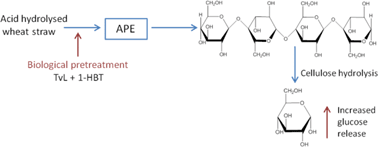Role of laccase as an enzymatic pretreatment method to improve lignocellulosic saccharification†
Abstract
The recalcitrant nature of lignocellulose, in particular due to the presence of lignin, is found to decrease the efficiency of cellulases during the saccharification of biomass. The efficient and cost effective removal of lignin is currently a critical biotechnological challenge in order to improve the enzymatic digestibility of cellulose for bioethanol production. In this study the role and reactivity of laccase from Trametes versicolor (TvL) was assessed with and without mediators for the improved saccharification of acid-pretreated wheat straw. Lignin model compound studies using veratryl alcohol and β–O–4 dimers revealed that 1-hydroxybenzotriazole (1-HBT) was the most effective mediator. Combination of TvL and TvL + 1-HBT treatments with an alkaline-peroxide extraction step increased the released glucose concentration following hydrolysis by up to 2.3 g L−1 compared to an untreated control. Pyrolysis-gas chromatography-mass spectrometry (py-GC-MS) with tetramethylammonium hydroxide (TMAH) thermochemolysis analysis of the extracted lignin revealed structural changes that are consistent with lignin degradation mechanisms typical of fungi.

- This article is part of the themed collection: Sustainable catalytic conversions of renewable substrates

 Please wait while we load your content...
Please wait while we load your content...